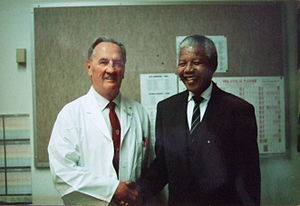John Brereton Barlow
| John Brereton Barlow | |
|---|---|

John Barlow with Nelson Mandela
|
|
| Born | 24 October 1924 Johannesburg, Union of South Africa |
| Died | 10 December 2008 (aged 84) Johannesburg, Republic of South Africa |
| Education |
University of the Witwatersrand Hammersmith Hospital Royal Postgraduate Medical School |
| Years active | 1951–2008 |
| Known for |
Mitral valve research Barlow's Syndrome |
| Medical career | |
| Profession | Physician |
| Institutions |
Royal Imperial Hospital, Baragwanath Johannesburg Hospital |
| Specialism | Cardiology |
John Brereton Barlow (24 October 1924 – 10 December 2008) was a world-renowned South African cardiologist. He qualified as a doctor in 1951, gained experience as a registrar in Hammersmith Hospital and the Royal Postgraduate Medical School in London. In the late 1950s he returned to South Africa to Johannesburg Hospital where he became Professor of Cardiology in the research unit and carried out significant studies on cardiac disorders as well as discovering the cause of a well known mitral valve disorder.
He gives his name to Barlow's Syndrome.
John Barlow commenced medical studies at the University of the Witwatersrand. However, shortly afterwards, in 1940 when South Africa became involved in World War II he enlisted in the military and spent time attached to British forces in North Africa and later the Fifth US Army in Italy. He returned to medical school in 1946 and graduated with MBBCh. in November 1951.
Barlow served his internship and registrar posts in the Royal Imperial Hospital, Baragwanath Hospital and in 1955 set sail for England to sit his examination for membership of the Royal College of Physicians. He worked as SHO to Sheila Sherlock and medical registrar under Mr John McMichael at Hammersmith Hospital and The Royal Post Graduate Medical School in London. It was during this time that Barlow became interested in auscultation and phonocardiography which led him to investigate non-ejection clicks and late systolic murmurs. The non-ejection click had long been thought to have an origin outside the heart. During his time at the Royal Postgraduate Medical School Barlow attended the postmortem examination of a patient who was known to have a 'click'. Barlow noticed that the man had a single fibrosed mitral valve chord, he also noted no abnormality outside the heart to account for the click. Barlow, by further investigation, was able to demonstrate that the cause of this widely known but little understood problem was due to a pathological condition of the mitral valve. This discovery by Barlow was controversial at the time and was met with scepticism by the cardiological community. His first paper on the subject was declined on the grounds that his assertions were extreme. A friend and former colleague persuaded Barlow to submit a shorter version of the paper to the Maryland State Medical Journal (of which his friend was a sub-editor) where it was published under the title "The Significance of Late Systolic Murmurs and Mid-Late Systolic Clicks". A second and ground-breaking paper was published in the American Heart Journal in October 1963. So significant was this paper that it became one of the most commonly cited papers in the AHJ and in 1983 was designated by the Institute for Scientific Information as a citation classic. In addition to his specialised work on the mitral valve he furthered research and published papers in other cardiac pathologies including the role of tricuspid regurgitation after mitral valve surgery; the role of a haemodynamic valve load as the origin of refractory heart failure in patients with active carditis; submitral aneurysm; hypertrophic cardiomyopathy and the time course of "false positive stress ECGs"
...
Wikipedia
